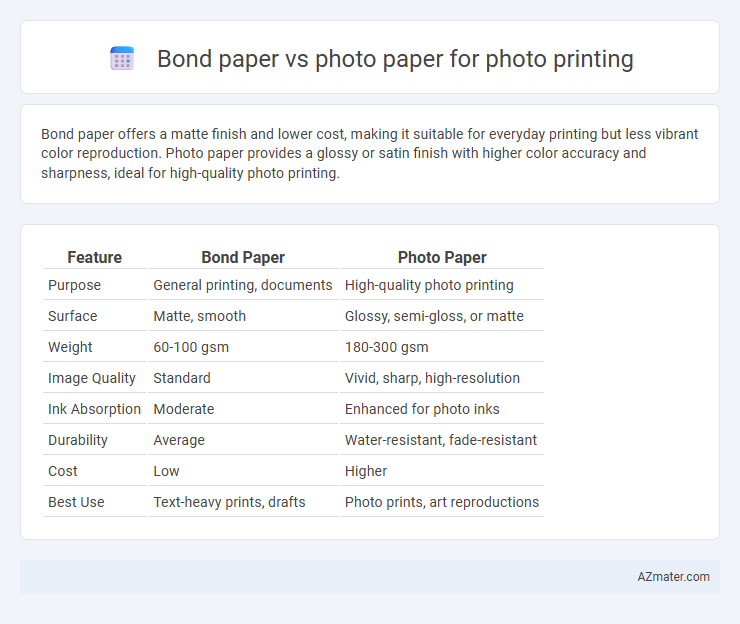Bond paper offers a matte finish and lower cost, making it suitable for everyday printing but less vibrant color reproduction. Photo paper provides a glossy or satin finish with higher color accuracy and sharpness, ideal for high-quality photo printing.
Table of Comparison
| Feature | Bond Paper | Photo Paper |
|---|---|---|
| Purpose | General printing, documents | High-quality photo printing |
| Surface | Matte, smooth | Glossy, semi-gloss, or matte |
| Weight | 60-100 gsm | 180-300 gsm |
| Image Quality | Standard | Vivid, sharp, high-resolution |
| Ink Absorption | Moderate | Enhanced for photo inks |
| Durability | Average | Water-resistant, fade-resistant |
| Cost | Low | Higher |
| Best Use | Text-heavy prints, drafts | Photo prints, art reproductions |
Understanding Bond Paper and Photopaper
Bond paper, typically made from cotton or wood pulp, offers durability and a smooth finish ideal for text and basic graphics but lacks the specialized coating required for vibrant photo prints. Photopaper features a light-sensitive coating that enhances color saturation, sharpness, and contrast, making it the preferred choice for high-quality photo printing. Choosing between bond paper and photopaper depends on whether you prioritize longevity and versatility or vivid, professional-grade image reproduction.
Key Differences in Material Composition
Bond paper consists primarily of cotton or rag fibers, offering durability and a matte surface ideal for text and office printing, whereas photopaper is coated with a layer of chemicals such as polyethylene or resin for enhanced color absorption and gloss. Photopaper typically features a higher brightness level and smoother finish optimized for photographic detail and vibrant color reproduction. The material composition of photopaper allows for better ink retention and water resistance compared to the porous, uncoated surface of bond paper.
Print Quality Comparison: Bond Paper vs Photopaper
Photopaper offers superior print quality compared to bond paper due to its specialized coating that enhances color vibrancy and sharpness, making images appear more lifelike and detailed. Bond paper, primarily designed for text and general office use, tends to absorb ink more deeply, resulting in duller colors and less precise image definition. For photo printing, photopaper's smooth surface and optimized ink absorption deliver professional-grade results with better contrast and longevity.
Color Vibrancy and Image Sharpness
Photopaper offers superior color vibrancy compared to bond paper, as it is specifically designed to absorb and display ink with rich, saturated hues ideal for photo printing. Image sharpness on photopaper is enhanced by its smooth, coated surface, which prevents ink bleed and maintains fine detail clarity. Bond paper, while suitable for text-heavy documents, lacks the glossy finish and absorption properties necessary for achieving high-quality photo prints with vivid colors and sharp images.
Durability and Longevity of Prints
Bond paper offers moderate durability with reasonable resistance to fading and moisture, making it suitable for everyday printing but less ideal for long-term photo preservation. Photopaper is specifically designed for photo printing, featuring a coated surface that enhances color vibrancy and provides superior resistance to water, fingerprints, and UV light, significantly extending the longevity of prints. For archival-quality photos, photopaper is the recommended choice due to its enhanced durability and ability to maintain image integrity over time.
Suitable Printers for Bond and Photopaper
Bond paper is best suited for inkjet and laser printers that handle everyday documents and black-and-white prints, offering durability and cost-efficiency. Photopaper is designed specifically for high-resolution inkjet printers with advanced color ink systems, enabling vibrant and detailed photo prints. Choosing the right paper depends on printer compatibility with the paper's weight, finish, and ink absorption capacity to achieve optimal print quality.
Cost Analysis and Budget Considerations
Bond paper generally costs significantly less than photopaper, making it a more budget-friendly option for large volume printing or projects with tight financial constraints. Photopaper, designed for high-quality photo prints, commands a higher price due to its specialized coatings and ability to produce vibrant, sharp images with superior color accuracy. When prioritizing cost, bond paper is suitable for draft prints or casual photo printing, while photopaper is an investment suited for professional or archival-quality photo prints where image quality justifies the additional expense.
Common Uses for Each Paper Type
Bond paper is commonly used for everyday printing tasks such as documents, letters, and reports due to its durability and affordability. Photopaper is specifically designed for high-quality photo printing, offering vibrant color reproduction and glossy or matte finishes ideal for photographs, brochures, and marketing materials. Both papers serve distinct purposes, with bond paper suited for text-heavy prints and photopaper optimized for visual clarity and detail in images.
Environmental Impact and Sustainability
Bond paper, typically made from wood pulp, has a moderate environmental footprint due to its resource-intensive manufacturing process and lower recyclability compared to photo paper. Photopaper, often coated with plastics and chemicals to enhance image quality, poses greater challenges for biodegradability and recycling, increasing environmental concerns within photo printing. Choosing FSC-certified bond paper or recycled photopaper can significantly reduce the ecological impact by promoting sustainable forest management and minimizing waste in photo printing applications.
Choosing the Best Paper for Photo Printing Needs
For photo printing needs, choosing between bond paper and photopaper hinges on the desired quality and finish; photopaper offers superior color reproduction, sharpness, and durability, making it ideal for high-resolution images and professional prints. Bond paper, while budget-friendly and versatile for text documents, lacks the glossy or matte finishes and color vibrancy essential for photo printing. Selecting photopaper ensures better longevity and visual impact, crucial for preserving photographic memories or creating display-quality prints.

Infographic: Bond paper vs Photopaper for Photo printing
 azmater.com
azmater.com